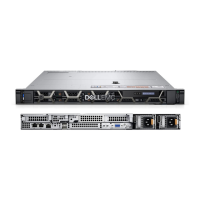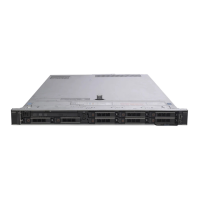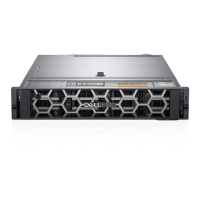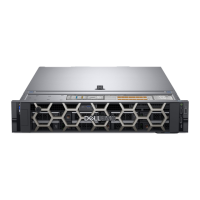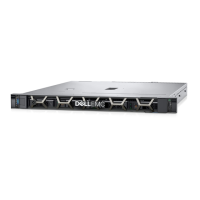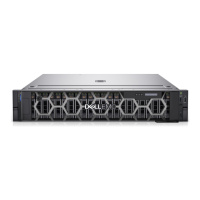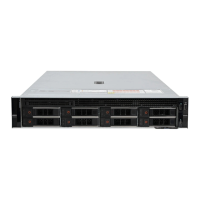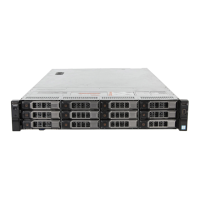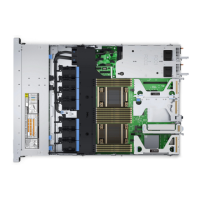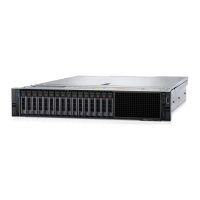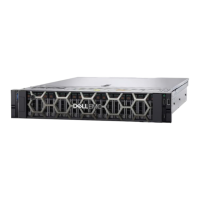Do you have a question about the Dell EMC PowerEdge R440 and is the answer not in the manual?
Displays the features available on the front of the system, including drive slots and control panels.
Indicates the status of the system, including hardware health and activity.
Describes iDRAC Quick Sync 2 indicator behavior for status and troubleshooting.
Explains NIC link and activity LED status for network connectivity.
Explains PSU status indicator lights for power presence and faults.
Explains drive activity and status LED indicators for drive health.
Configure BIOS, iDRAC, and device settings via the LCD panel.
View system properties such as IP, MAC, name, power, and temperature.
Links to documentation for system installation and rack mounting.
Links to documentation for iDRAC and remote system management.
Links to documentation for Dell system management software.
Provides physical dimensions of the PowerEdge R440 system.
Details the maximum weight of the system with drives.
Specifies supported processor types and configurations.
Lists supported AC or DC power supply units (PSUs).
Details memory module support, capacity, and frequencies.
Details system ports, including USB, NIC, serial, and VGA.
Outlines operating temperature, humidity, and vibration limits.
Specifies normal operating temperature ranges for the system.
Details extended operating temperature ranges and limitations.
Shows thermal limits based on CPU TDP, core count, and ambient temperature.
Provides a step-by-step guide for initial system setup.
Details iDRAC setup and configuration procedures.
Instructions for accessing and logging into the iDRAC interface.
Explains various methods to obtain system firmware and drivers.
Steps to download the latest drivers and firmware from Dell's support site.
General safety precautions for handling server components.
Lists the necessary tools for component removal and installation.
Steps to remove the optional front bezel from the system.
Steps to remove the system cover for internal access.
Steps to remove the backplane cover.
Steps to remove the air shroud for component access.
Steps to remove a cooling fan from the system.
Describes the internal PERC riser for storage performance.
Steps to remove the internal PERC riser assembly.
Steps to remove a PERC card from its riser.
Function of the chassis intrusion switch for security.
Steps to remove the chassis intrusion switch.
Overview of hot-swappable drive carriers and installation.
Steps to remove a drive blank from the drive slot.
Steps to remove a 2.5-inch drive from its 3.5-inch adapter.
Steps to remove a 3.5-inch drive adapter from its carrier.
Steps to remove a hard drive from the system.
Overview of DDR4 RDIMM and LRDIMM support.
Steps to remove a memory module from its socket.
Role of processors and heat sinks for system operation.
Steps to remove a processor and heat sink module.
Explains expansion card functionality and riser types.
Steps to remove an expansion card from its riser.
Steps to install an expansion card into its riser.
Steps to remove an expansion card riser.
Functionality of the IDSDM/vFlash card.
Steps to remove a MicroSD card from the module.
Steps to remove the optional IDSDM or vFlash card.
Describes the LOM riser card for network connectivity.
Steps to remove the LOM riser card.
Supported hard drive backplane options.
Steps to remove the hard drive backplane.
Function of the system battery for low-level functions.
Steps to replace the system battery.
Functionality of the optional internal USB memory key.
Steps to replace the optional internal USB memory key.
Steps to remove the optical drive from the system.
Overview of supported power supply units (PSUs).
Steps to remove a power supply unit blank.
Steps to remove a power supply unit from the system.
Steps to remove a non-redundant cabled AC power supply unit.
Describes the power interposer board and its function.
Steps to remove the power interposer board.
Role and function of the system board (motherboard).
Steps to remove the system board from the chassis.
Defines the Trusted Platform Module (TPM) and its purpose.
Steps to replace the Trusted Platform Module.
Lists options for managing system settings before OS boot.
Configure BIOS, iDRAC, and device settings via the setup utility.
Access and configure BIOS settings like boot order and passwords.
View system properties like Service Tag, model name, and BIOS version.
View and configure system memory settings.
View and configure processor settings like virtualization and speed.
View and configure SATA device settings and RAID modes.
Set the system's boot mode (BIOS/UEFI) and boot order.
Selects between BIOS and UEFI boot modes for OS installation.
Configure UEFI PXE, iSCSI, and HTTP boot settings.
Configure integrated devices like video controller and USB ports.
View and configure serial communication port properties.
Configure system performance settings and power management.
Set system passwords and security features.
Steps to create system and setup passwords.
Steps to delete or change existing system and setup passwords.
Configure redundant OS settings for recovery.
Update asset tag, system date, and time.
Configure iDRAC parameters using UEFI.
Configure device parameters.
Advanced system deployment, configuration, and update features.
Select boot options and diagnostic utilities.
Overview of ePSA diagnostics for system hardware testing.
Instructions to run diagnostics from Boot Manager.
Instructions to run diagnostics from the Lifecycle Controller.
Controls and views for system diagnostics, including results and logs.
Identifies system board jumpers, switches, and connectors.
Details jumper configurations for BIOS settings.
Steps to disable forgotten system and setup passwords using a jumper.
Provides options for contacting Dell technical support and sales.
How to provide feedback on the manual's content.
Using Quick Resource Locator (QRL) to access system information.
Overview of Dell SupportAssist for automated technical support.
Displays the features available on the front of the system, including drive slots and control panels.
Indicates the status of the system, including hardware health and activity.
Describes iDRAC Quick Sync 2 indicator behavior for status and troubleshooting.
Explains NIC link and activity LED status for network connectivity.
Explains PSU status indicator lights for power presence and faults.
Explains drive activity and status LED indicators for drive health.
Configure BIOS, iDRAC, and device settings via the LCD panel.
View system properties such as IP, MAC, name, power, and temperature.
Links to documentation for system installation and rack mounting.
Links to documentation for iDRAC and remote system management.
Links to documentation for Dell system management software.
Provides physical dimensions of the PowerEdge R440 system.
Details the maximum weight of the system with drives.
Specifies supported processor types and configurations.
Lists supported AC or DC power supply units (PSUs).
Details memory module support, capacity, and frequencies.
Details system ports, including USB, NIC, serial, and VGA.
Outlines operating temperature, humidity, and vibration limits.
Specifies normal operating temperature ranges for the system.
Details extended operating temperature ranges and limitations.
Shows thermal limits based on CPU TDP, core count, and ambient temperature.
Provides a step-by-step guide for initial system setup.
Details iDRAC setup and configuration procedures.
Instructions for accessing and logging into the iDRAC interface.
Explains various methods to obtain system firmware and drivers.
Steps to download the latest drivers and firmware from Dell's support site.
General safety precautions for handling server components.
Lists the necessary tools for component removal and installation.
Steps to remove the optional front bezel from the system.
Steps to remove the system cover for internal access.
Steps to remove the backplane cover.
Steps to remove the air shroud for component access.
Steps to remove a cooling fan from the system.
Describes the internal PERC riser for storage performance.
Steps to remove the internal PERC riser assembly.
Steps to remove a PERC card from its riser.
Function of the chassis intrusion switch for security.
Steps to remove the chassis intrusion switch.
Overview of hot-swappable drive carriers and installation.
Steps to remove a drive blank from the drive slot.
Steps to remove a 2.5-inch drive from its 3.5-inch adapter.
Steps to remove a 3.5-inch drive adapter from its carrier.
Steps to remove a hard drive from the system.
Overview of DDR4 RDIMM and LRDIMM support.
Steps to remove a memory module from its socket.
Role of processors and heat sinks for system operation.
Steps to remove a processor and heat sink module.
Explains expansion card functionality and riser types.
Steps to remove an expansion card from its riser.
Steps to install an expansion card into its riser.
Steps to remove an expansion card riser.
Functionality of the IDSDM/vFlash card.
Steps to remove a MicroSD card from the module.
Steps to remove the optional IDSDM or vFlash card.
Describes the LOM riser card for network connectivity.
Steps to remove the LOM riser card.
Supported hard drive backplane options.
Steps to remove the hard drive backplane.
Function of the system battery for low-level functions.
Steps to replace the system battery.
Functionality of the optional internal USB memory key.
Steps to replace the optional internal USB memory key.
Steps to remove the optical drive from the system.
Overview of supported power supply units (PSUs).
Steps to remove a power supply unit blank.
Steps to remove a power supply unit from the system.
Steps to remove a non-redundant cabled AC power supply unit.
Describes the power interposer board and its function.
Steps to remove the power interposer board.
Role and function of the system board (motherboard).
Steps to remove the system board from the chassis.
Defines the Trusted Platform Module (TPM) and its purpose.
Steps to replace the Trusted Platform Module.
Lists options for managing system settings before OS boot.
Configure BIOS, iDRAC, and device settings via the setup utility.
Access and configure BIOS settings like boot order and passwords.
View system properties like Service Tag, model name, and BIOS version.
View and configure system memory settings.
View and configure processor settings like virtualization and speed.
View and configure SATA device settings and RAID modes.
Set the system's boot mode (BIOS/UEFI) and boot order.
Selects between BIOS and UEFI boot modes for OS installation.
Configure UEFI PXE, iSCSI, and HTTP boot settings.
Configure integrated devices like video controller and USB ports.
View and configure serial communication port properties.
Configure system performance settings and power management.
Set system passwords and security features.
Steps to create system and setup passwords.
Steps to delete or change existing system and setup passwords.
Configure redundant OS settings for recovery.
Update asset tag, system date, and time.
Configure iDRAC parameters using UEFI.
Configure device parameters.
Advanced system deployment, configuration, and update features.
Select boot options and diagnostic utilities.
Overview of ePSA diagnostics for system hardware testing.
Instructions to run diagnostics from Boot Manager.
Instructions to run diagnostics from the Lifecycle Controller.
Controls and views for system diagnostics, including results and logs.
Identifies system board jumpers, switches, and connectors.
Details jumper configurations for BIOS settings.
Steps to disable forgotten system and setup passwords using a jumper.
Provides options for contacting Dell technical support and sales.
How to provide feedback on the manual's content.
Using Quick Resource Locator (QRL) to access system information.
Overview of Dell SupportAssist for automated technical support.
| Form Factor | 1U rack server |
|---|---|
| Network Interface | 2 x 1GbE LOM |
| Memory Slots | 16 DIMM slots |
| Operating System Support | Windows Server, Red Hat Enterprise Linux, SUSE Linux Enterprise Server, VMware ESXi |
| Processor | Up to 2 x Intel Xeon Scalable processors |
| Memory | Up to 1TB DDR4 ECC RDIMM, speeds up to 2666MT/s |
| Drive Bays | Up to 10 x 2.5" or 4 x 3.5" SAS/SATA (HDD/SSD) |
| Power Supply | 750W |
| RAID Controller | PERC H330, H730P, H740P |
| Chipset | Intel C620 |
| Expansion Slots | 3 x PCIe 3.0 slots |
